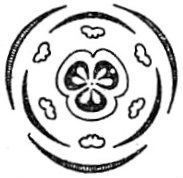Fritillaria
Fritillaria is a genus of spring flowering herbaceous plants in the lily family, Liliaceae. The type species, Fritillaria meleagris, was first described in Europe in the 16th century, highlighting the genus's long history of cultivation and appreciation. The name Fritillaria is derived from the Latin term fritillus, meaning dice-box, possibly referring to the checkered pattern on the flowers of some species. This genus is noted for its unique bell-shaped flowers, which exhibit a wide range of colors and patterns. The distribution of Fritillaria spans across the temperate regions of the Northern Hemisphere, with a high concentration of species in the Mediterranean region, the Middle East, and western North America.
Description[edit | edit source]
Fritillaria species vary greatly in size and form but are generally characterized by their nodding, bell- or cup-shaped flowers. They can range from just a few centimeters tall, like Fritillaria pusilla, to over a meter, as seen in Fritillaria imperialis. The leaves are usually lanceolate or linear, with a glaucous or glossy finish, arranged in a whorl or alternately up the stem. The flowers are most commonly solitary, but in some species, they are borne in racemes. They exhibit a wide variety of colors, including white, yellow, orange, red, purple, and almost black, with many species featuring flowers with a checkered pattern.
Ecology[edit | edit source]
Fritillaria species are adapted to a range of habitats, from woodlands and meadows to scrublands and alpine regions. They tend to prefer well-drained soils and are often found in areas that provide a dry summer period, which is essential for their dormancy cycle. Pollination is typically by insects, including bees, which are attracted to the nectar and pollen provided by the flowers. Some species of Fritillaria are known to emit a scent that is unpleasant to humans but attractive to their pollinators.
Cultivation[edit | edit source]
Fritillaria bulbs are popular among gardeners and are cultivated for their distinctive flowers. They require well-drained soil and a position in full sun or partial shade. It is crucial to avoid waterlogged conditions, especially during the dormant period in summer. Some species, such as Fritillaria meleagris and Fritillaria imperialis, are more commonly grown and readily available from nurseries. Bulbs should be planted in autumn for flowering in spring. Despite their exotic appearance, many Fritillaria species are hardy and, once established, require minimal care.
Conservation[edit | edit source]
Several Fritillaria species are considered at risk due to habitat loss, over-collection, and climate change. Conservation efforts are in place for some species, focusing on habitat protection and the regulation of bulb collection. The cultivation of Fritillaria species in gardens can aid in their conservation by reducing the demand for wild-collected bulbs.
Species[edit | edit source]
The genus Fritillaria comprises about 130 to 140 species. Some notable species include:
- Fritillaria meleagris – Snake's head fritillary, known for its nodding, checkered flowers.
- Fritillaria imperialis – Crown imperial, distinguished by its tall stature and crown of flowers above a tuft of leaves.
- Fritillaria persica – Persian fritillary, with its striking spikes of dark purple flowers.
- Fritillaria affinis – Checker lily or chocolate lily, native to western North America.
Cultural Significance[edit | edit source]
In addition to their horticultural appeal, Fritillaria species have various cultural significances. For example, Fritillaria meleagris is the county flower of Oxfordshire, UK, and has been featured in literature and art for centuries. In traditional medicine, certain Fritillaria species have been used to treat respiratory conditions.
Search WikiMD
Ad.Tired of being Overweight? Try W8MD's NYC physician weight loss.
Semaglutide (Ozempic / Wegovy and Tirzepatide (Mounjaro / Zepbound) available. Call 718 946 5500.
Advertise on WikiMD
|
WikiMD's Wellness Encyclopedia |
| Let Food Be Thy Medicine Medicine Thy Food - Hippocrates |
Translate this page: - East Asian
中文,
日本,
한국어,
South Asian
हिन्दी,
தமிழ்,
తెలుగు,
Urdu,
ಕನ್ನಡ,
Southeast Asian
Indonesian,
Vietnamese,
Thai,
မြန်မာဘာသာ,
বাংলা
European
español,
Deutsch,
français,
Greek,
português do Brasil,
polski,
română,
русский,
Nederlands,
norsk,
svenska,
suomi,
Italian
Middle Eastern & African
عربى,
Turkish,
Persian,
Hebrew,
Afrikaans,
isiZulu,
Kiswahili,
Other
Bulgarian,
Hungarian,
Czech,
Swedish,
മലയാളം,
मराठी,
ਪੰਜਾਬੀ,
ગુજરાતી,
Portuguese,
Ukrainian
Medical Disclaimer: WikiMD is not a substitute for professional medical advice. The information on WikiMD is provided as an information resource only, may be incorrect, outdated or misleading, and is not to be used or relied on for any diagnostic or treatment purposes. Please consult your health care provider before making any healthcare decisions or for guidance about a specific medical condition. WikiMD expressly disclaims responsibility, and shall have no liability, for any damages, loss, injury, or liability whatsoever suffered as a result of your reliance on the information contained in this site. By visiting this site you agree to the foregoing terms and conditions, which may from time to time be changed or supplemented by WikiMD. If you do not agree to the foregoing terms and conditions, you should not enter or use this site. See full disclaimer.
Credits:Most images are courtesy of Wikimedia commons, and templates, categories Wikipedia, licensed under CC BY SA or similar.
Contributors: Prab R. Tumpati, MD





